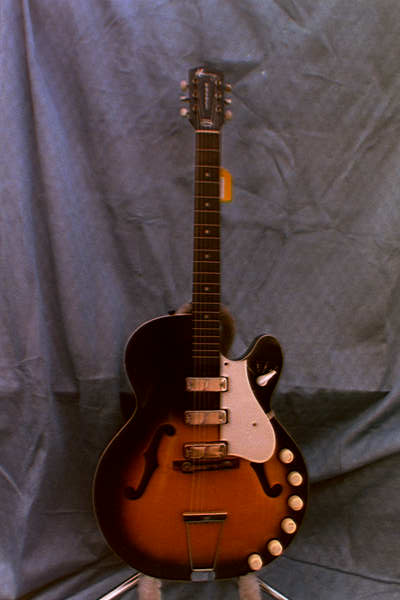|

As the space age came about in the early 60's, there was a wide-range of influence on the youth of America. It was the dream
on many a kid to shoot to the stars and explore the outer reaches of the universe. Back here on earth, there was a music revolution
going on and it was the dream of many to shoot for rock and roll stardom. The instrument makers of this time were influenced
by this parallel dream of the youth of America, when naming their instruments
My latest direction with Harmony Guitars,
comes from the fascination with the hollow and semi hollow body, thin line guitars from the 60?The Harmony Rockets have always
been a guitar that caught my interest. These Rockets, whose name was influenced by the space race of the 60?were fun instruments
to play. The sound that was characterized by the DeArmond pickups they used gave them a unique sound that is still sought
after today. I have acquired several of these guitars over the past few months and continue to be fascinated by their details,
playability and sound.
The Harmony Guitar Company was very influenced by mans quest to explore the heavens. They
had their Meteors, they had their Stratatone Mars, Mercury and Jupiters, but one of the more popular guitars was the Harmony
Rocket. Whether it was a Red Rocket or their top of the line H-75, these guitars really rocked. A cheap alternative to the
thin Gibson ES-125s, or the ES-330s, these guitars gained in popularity as the music revolution took off.
There
was a whole assortment of configurations of these guitars. The early 60?rought about the single cutaway Rocket with ?ra thin
cutaway with golden tone indox pickups.??ey had their one pickup model. This H53, as the other 2 and 3 pickup models had ?mony?ltra
thin arched tone chamber construction.??e H54 Rocket II, had two pickups, as the Rocket III, H59 had three. With a selector
switch to permit playing either pickup, these guitars were very versatile for lead or rhythm players. The catalogues boasted
?standing modern design, quality and value.??ey all had the hardwood bodies with celluloid binding.


In the mid 60?he line remained consistent. Features remained the same, equip with bezel mounted adjustable gold tone pickups.
These DeArmond pickups and their appointments, tried to appeal to the young market they were targeting. By 1971 the had Golden
tone pickups with individual adjusting pole pieces under each string, " to allow you to balance response." With
the addition of the H56/1 with a ?e W,??broto tailpiece, Harmony added, ? pleasing sounds, and effects of vibrato desired
by today?uitarist are had by simply wavering the arm.??wards the end of the decade the Harmony Rocket progressed to compete
with the appeal of the double cutaway guitars. These guitars designated the same models, had similar features. With their
richly polished cherry red lacquer finish, these guitars established themselves in American guitar history.
One
of the more unusual was a Rocket that had 6 on one-side tuners; kind of a cross between the Gibson and Fender guitars they
were trying to emulate. These guitars also had DeArmond pickups and appointments that tried to appeal to the young market
they were targeting. Many of these guitars were Red, but there were also some sunburst models.

The Rockets were the less expensive alternative in Harmony?ine. The more expensive H73, for example, sold for $
175, in 1968. This was almost $50 more than the similar H56 Rocket VII. This was a fair amount of money at the time, making
the Rockets quite desirable to the young guitarist. No other Harmony Electric survived in the line like the Rockets did. From
their inception in the early 60's, these guitars evolved and changed to utilize the guitar technology of the times, up until
Harmony gave up guitar production in the early 70's. One of the more popular hollow body thin line, they are still in demand
today. A vintage American guitar that is still affordable and even today, captures the dreams of the baby boomer generation
while also appealing to Generation X
|



